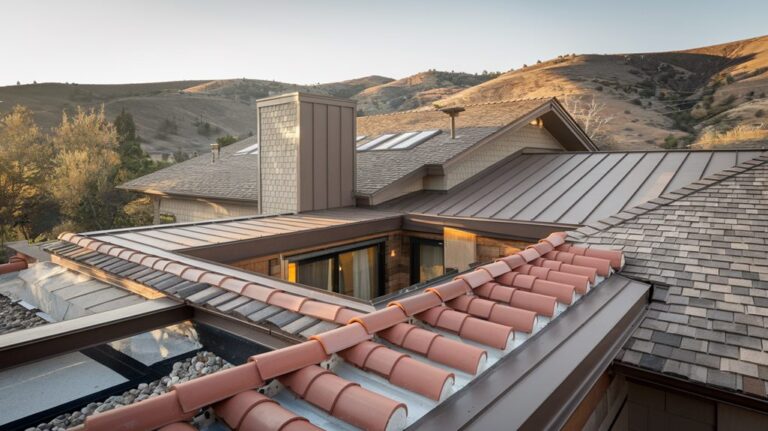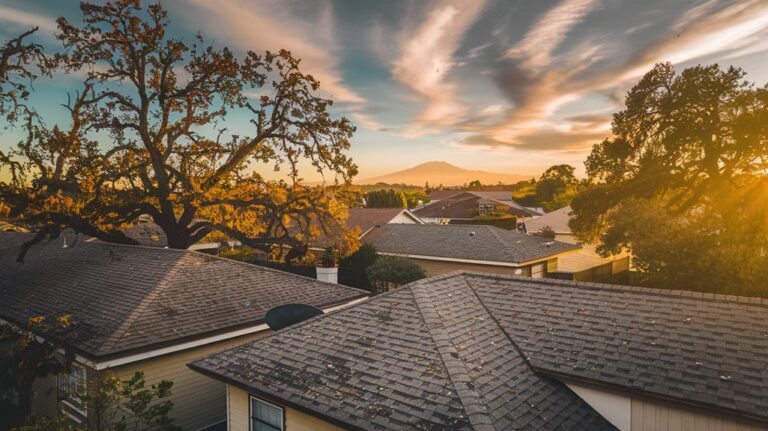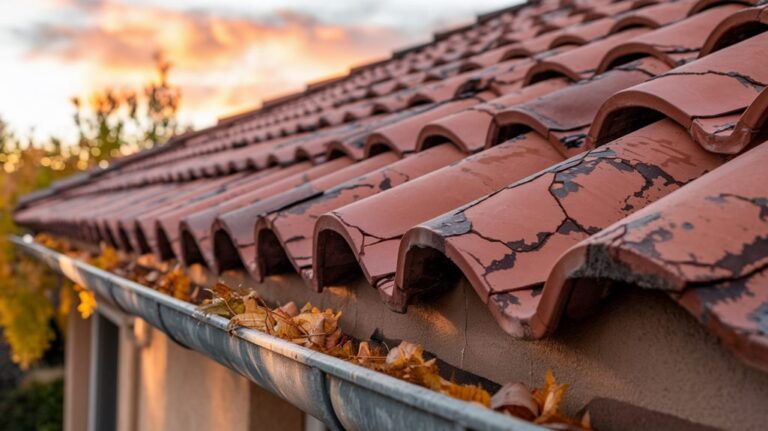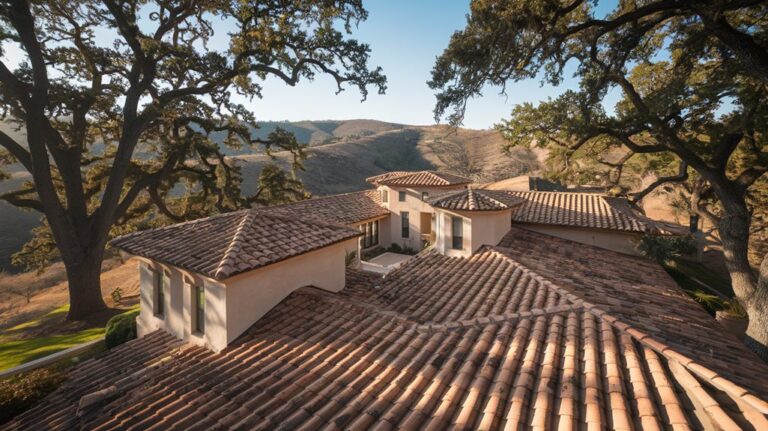For Walnut Creek's Mediterranean climate, you'll want roofing materials that handle both intense summer heat and winter rains. Clay or concrete tiles offer exceptional durability, lasting 40-50 years while managing temperature fluctuations effectively. Metal roofing provides another sturdy option, reflecting sunlight to reduce cooling costs by up to 30%. If you're budget-conscious, consider Class A fire-rated architectural shingles with enhanced underlayment – they'll protect your home for 20-25 years while meeting local building codes. Smart material choices now can lead to significant savings through reduced energy bills and lower insurance premiums. Discover which specific features will maximize your home's protection in Walnut Creek's unique conditions.
Bay Area Homeowners' Guide
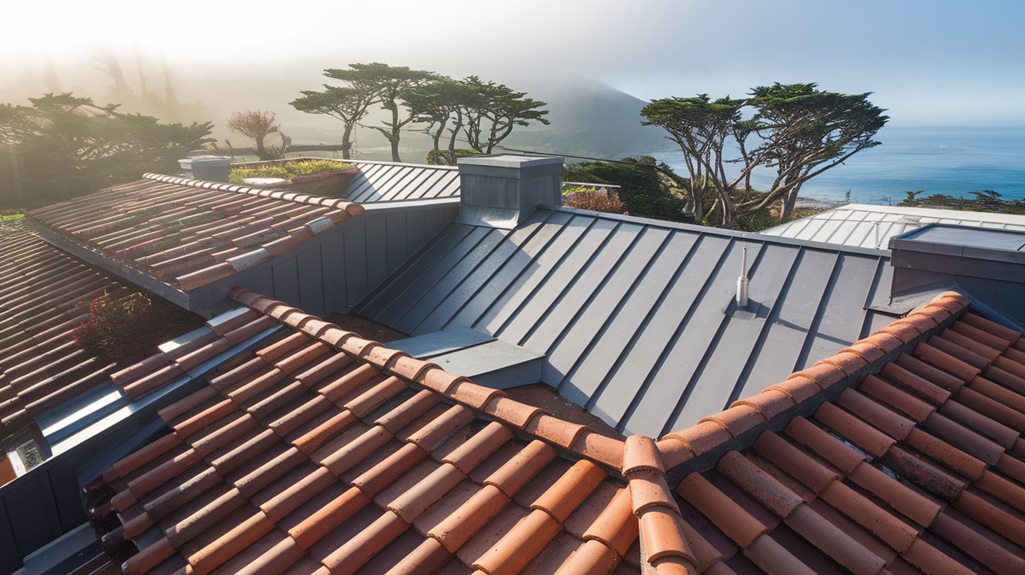
In light of the Bay Area's unique microclimate patterns, choosing the right roofing material for your Walnut Creek home requires careful consideration. You'll need to account for hot, dry summers with temperatures reaching 90°F, mild winters with occasional frost, and moisture from coastal fog that can affect roofing materials.
Before selecting your roofing material, you'll want to evaluate several key factors. Consider your home's architectural style, local building codes, and your budget for both initial installation and long-term maintenance. You'll also need to factor in Walnut Creek's exposure to UV rays and seasonal temperature fluctuations.
As a Bay Area homeowner, you should assess your roof's pitch and structural support. Steep-pitched roofs shed water more effectively but may require additional installation costs. If you're planning to install solar panels, you'll need a roof that can support the extra weight and withstand professional installation.
Don't forget to check your homeowner's insurance requirements and HOA regulations, as these may influence your material choice. It's also worth consulting local roofing contractors who understand Walnut Creek's specific climate challenges and can recommend materials that have performed well in similar conditions.
Storm-Resistant Roof Saves Home
When severe storms battered the Bay Area last winter, a Walnut Creek family's recently installed storm-resistant roof proved its worth. Their impact-resistant shingles and reinforced underlayment system prevented water damage and withstood flying debris, while several neighboring homes suffered significant roof damage.
You'll find that storm-resistant roofing systems combine multiple protective elements. Class 4 impact-resistant shingles resist hail and falling branches, while enhanced underlayment creates a watertight barrier. Additional features include reinforced fastening systems and specialized roof deck sealing that prevents wind uplift.
If you're considering a storm-resistant roof, you'll need to factor in Walnut Creek's specific weather challenges. Your roof should handle both winter storms and summer heat, with materials rated for 130 mph winds and large hail impacts. You'll want to choose synthetic underlayment that prevents moisture buildup and proper ventilation to extend your roof's lifespan.
The cost of storm-resistant roofing typically runs 20-30% higher than standard materials, but you'll often recover this investment through reduced repair costs and lower insurance premiums. Many insurers offer discounts up to 30% for certified storm-resistant roofing systems.
Protecting Your Home Investment
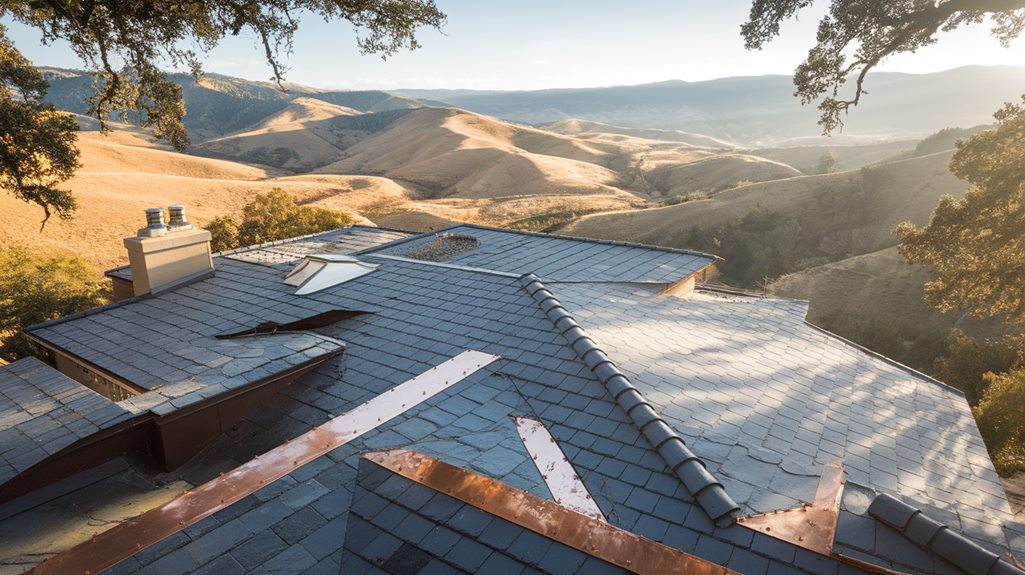
Making smart roofing choices safeguards your largest investment – your home. In Walnut Creek's variable climate, selecting the right roofing material can prevent costly damage and maintain your property's value. You'll need to take into account factors like durability, energy efficiency, and long-term maintenance costs when making your decision.
To maximize your home's protection, you'll want to focus on materials that can withstand both summer heat and winter rains. Class A fire-rated materials like concrete tiles or metal roofing offer superior protection and can reduce your insurance premiums. You'll also benefit from selecting reflective materials that lower cooling costs during hot months.
Don't overlook the warranty coverage when calculating your investment. While premium materials like slate or metal might cost more upfront, their 50+ year lifespan often justifies the expense. You should also take into consideration your home's resale value – quality roofing materials can increase it by 5-7%. Remember to schedule regular inspections and maintenance to protect your investment. When you maintain your roof properly, you're not just safeguarding the structure; you're safeguarding your home's market value and your family's comfort.
Aging Roofs Need Replacement
Every roof eventually reaches the end of its serviceable life, and Walnut Creek homes are no exception. You'll need to recognize the telltale signs that indicate your roof requires replacement, including curling shingles, missing granules, and persistent leaks that keep returning despite repairs.
In Walnut Creek's Mediterranean climate, with its hot summers and wet winters, most asphalt shingle roofs last 20-25 years, while tile roofs can endure 40-50 years. Don't wait until water damage appears on your ceiling – by then, you're dealing with a much costlier problem. You'll want to schedule regular inspections, especially if your roof is approaching the end of its expected lifespan.
Watch for these critical warning signs: daylight showing through roof boards, sagging areas, dark streaks from algae growth, and granules collecting in gutters. If your neighbors are replacing their roofs, take note – homes built around the same time often need roof replacement within a similar timeframe. When multiple repairs become frequent, it's usually more cost-effective to invest in a complete replacement rather than continue with temporary fixes that won't solve the underlying deterioration.
Energy-Efficient Roofing Cuts Costs
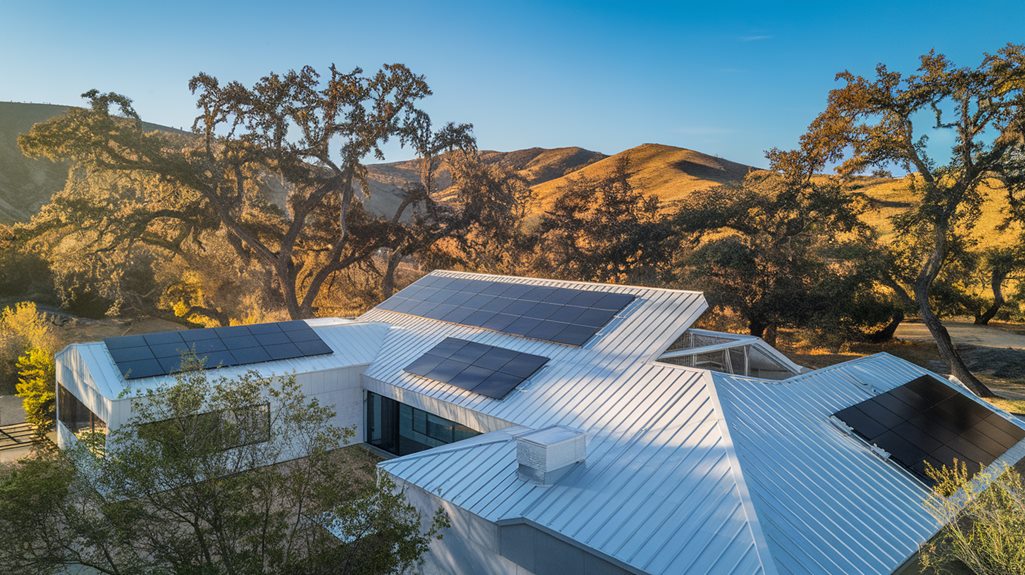
Smart homeowners in Walnut Creek can greatly reduce their energy bills by choosing the right roofing materials. You'll find that energy-efficient roofing options like cool roofs and reflective shingles can lower your cooling costs by 15-30% during hot summer months. These materials reflect sunlight instead of absorbing heat, keeping your home's interior temperature more stable.
When you're selecting energy-efficient roofing, consider materials like light-colored concrete tiles, metal roofing with reflective coatings, or specialized "cool" asphalt shingles. Metal roofs can reflect up to 85% of solar heat, while Energy Star-rated shingles deflect about 65%. You'll also benefit from proper insulation and ventilation systems that work alongside these materials.
The upfront cost of energy-efficient roofing is typically 10-15% higher than standard options, but you'll recover this investment through reduced energy bills within 5-7 years. Additionally, many utility companies offer rebates for installing energy-efficient roofing, and you might qualify for federal tax credits. By choosing these materials, you're not just saving money – you're also reducing your home's carbon footprint and extending your roof's lifespan due to decreased heat stress.
Mediterranean Microclimate Influences Roofing
Walnut Creek's Mediterranean microclimate shapes your roofing material choices in unique ways. You'll need to account for hot, dry summers with temperatures reaching 90°F and mild, wet winters that bring 20-25 inches of annual rainfall. These distinct seasonal patterns affect how your roof performs throughout the year.
For this microclimate, you'll want materials that excel at both heat reflection and moisture resistance. Clay and concrete tiles work exceptionally well, as they've been used in Mediterranean regions for centuries. They reflect sunlight effectively during summer months and resist water penetration during winter rains. You'll also benefit from their natural thermal properties, which help regulate indoor temperatures.
If you're considering alternatives, composite shingles with cool-roof technology can handle Walnut Creek's climate variations. They're engineered to reflect more sunlight than traditional asphalt shingles and won't crack under rapid temperature changes. Metal roofing also performs well, offering excellent rain resistance and heat reflection when properly coated. You'll find its durability particularly valuable during occasional winter storms and extended summer heat waves that characterize Walnut Creek's Mediterranean weather pattern.
Hot Summers, Mild Winters
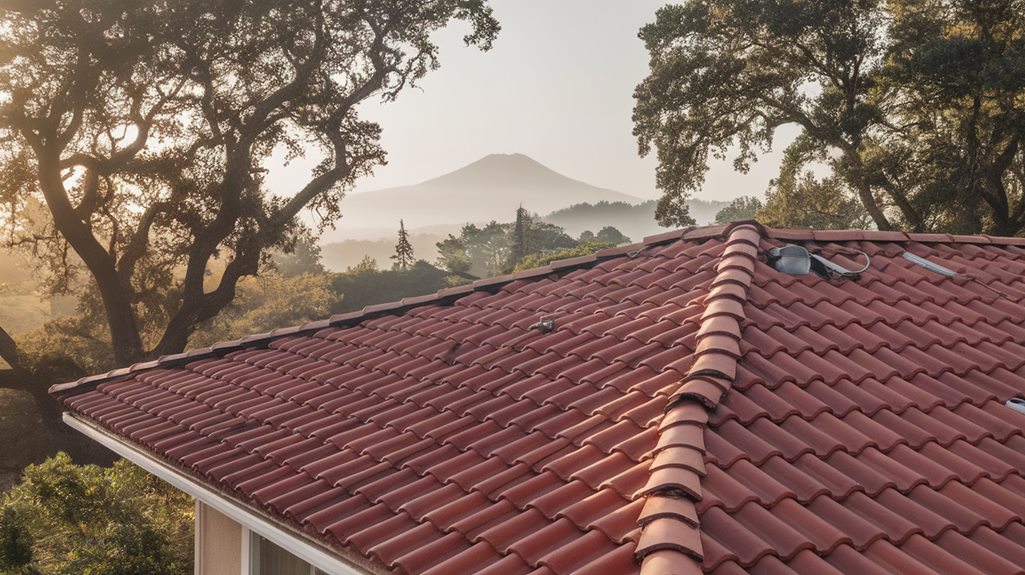
The distinct seasonal temperatures in Walnut Creek present specific challenges for roofing materials. You'll experience summer temperatures that frequently climb above 90°F, while winter lows typically stay above freezing, rarely dipping below 40°F. This temperature variation can cause roofing materials to expand and contract, affecting their longevity and performance.
During the hot summers, your roof absorbs significant solar radiation, which can lead to heat buildup in your attic and increased cooling costs. You'll want materials that reflect sunlight and resist UV damage, particularly during the June-September peak heat period. Cool roofing options, like light-colored tiles or specially coated shingles, can help maintain comfortable indoor temperatures.
In winter, you'll face occasional rain and mild temperatures, but you won't need to worry about heavy snow loads or ice dams. However, you should still make sure your roofing material can handle periodic rain storms and maintain its integrity during the wet season. The mild winters mean you can focus more on heat resistance than cold-weather durability when selecting your roofing material.
Spanish Colonial Style Homes
Harmonizing with Walnut Creek's Mediterranean climate, Spanish Colonial style homes feature distinctive architectural elements that influence roofing choices. The hallmark terracotta clay tiles, whether traditional barrel-style or modern S-tiles, aren't just decorative – they're engineered to withstand both summer heat and winter rains while maintaining the home's authentic character.
You'll find that clay tiles offer superior thermal properties, keeping your home cooler in summer by reflecting sunlight and providing natural insulation. They're also highly resistant to fire, which is vital in Walnut Creek's dry season. While they're more expensive upfront, you can expect these tiles to last 50-100 years with proper maintenance.
If you're considering alternatives to traditional clay, you'll want to look at concrete tiles that mimic the Spanish Colonial aesthetic. They're more affordable and offer similar durability, though they're heavier and may require additional structural support. For a modern twist, you might explore synthetic tiles made from recycled materials – they're lightweight and can replicate the classic Spanish look while providing enhanced durability and requiring less maintenance than their clay counterparts.
Building Permit R-3 Requirements
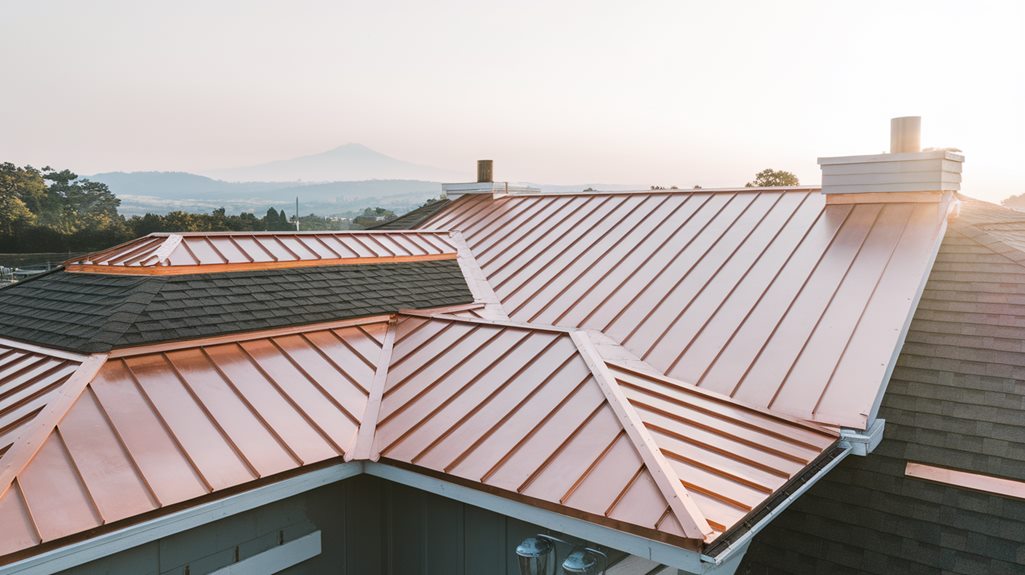
Before commencing any roofing undertaking in Walnut Creek, you'll need to secure an R-3 building permit, which encompasses residential construction and alterations. The city's Building Division strictly enforces these requirements to guarantee safety and compliance with local building codes.
To acquire your R-3 permit, you'll need to submit detailed documentation and meet specific criteria:
- Complete permit application forms with project scope, including material specifications and total square footage of the roofing area
- Provide two sets of construction drawings showing roof plan, structural details, and fire-resistance ratings
- Submit documentation proving compliance with Title 24 energy requirements, particularly for cool roof standards
- Include proof of worker's compensation insurance if you're hiring a contractor
- Pay the required permit fees, which vary based on project valuation
The permit process typically takes 5-10 business days for review. You'll need to schedule mandatory inspections during key phases of your roofing project, including a pre-roofing inspection and final inspection. Don't forget that your permit will expire after 180 days if work hasn't begun, so plan your timeline accordingly. Your contractor should be familiar with these requirements and can often handle the permit process on your behalf.
Essential Roofing Material Features
Selecting your roof's materials requires careful consideration of several key performance features that directly impact longevity and protection in Walnut Creek's Mediterranean climate. You'll need materials that can withstand intense summer heat, occasional winter rains, and UV exposure while maintaining structural integrity.
Your roofing materials must demonstrate excellent water resistance to prevent moisture penetration during rainy seasons. Look for products with proven waterproofing capabilities and proper overlap design to channel water effectively. Heat reflection and thermal resistance are critical – you'll want materials that can reflect solar radiation and prevent heat transfer into your home, reducing cooling costs.
Wind resistance is another essential feature, as your roofing materials should withstand occasional strong gusts without lifting or separating. Fire resistance ratings are particularly important in Walnut Creek's wildfire-prone region – Class A-rated materials offer the highest protection. You'll also need materials with proven impact resistance to protect against falling branches and occasional hail.
Consider the material's weight capacity, ensuring your roof structure can support it long-term. The material's expansion and contraction properties must accommodate Walnut Creek's temperature fluctuations without compromising structural integrity.
Popular Roofing Material Choices
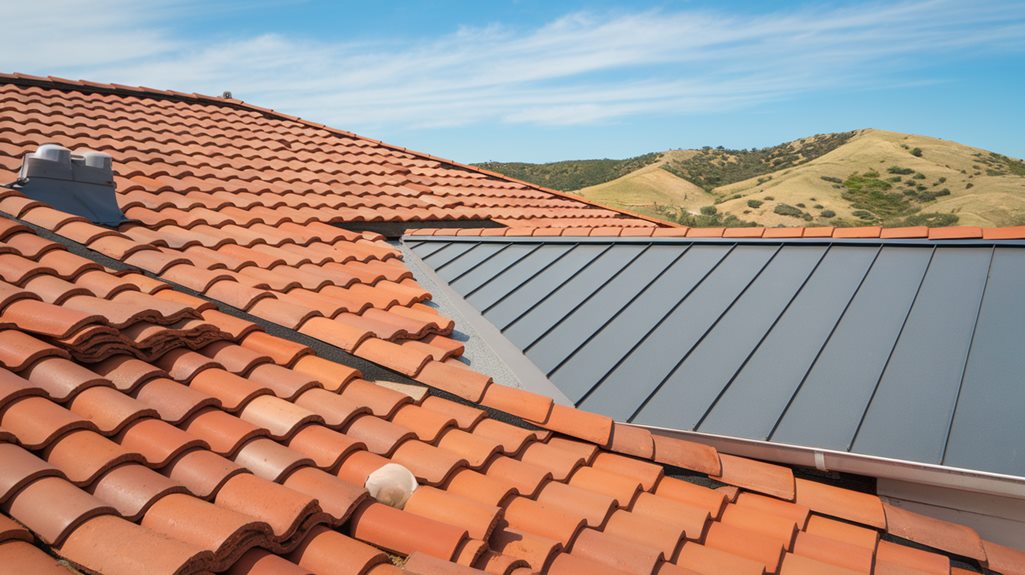
Several roofing materials have proven their worth in Walnut Creek's distinct climate, each offering unique advantages for homeowners. You'll find that these materials can endure both the warm summers and mild winters while providing excellent protection for your home.
- Concrete tiles remain a top choice, offering superior durability and fire resistance while preserving their color for decades in the California sun
- Asphalt shingles provide a cost-effective solution that's easy to install and repair, with newer versions featuring enhanced UV protection
- Clay tiles complement Mediterranean-style homes common in Walnut Creek, while offering excellent thermal properties and a lifespan of up to 50 years
- Metal roofing, particularly standing seam panels, reflects solar heat and can greatly reduce your cooling costs during hot summers
- Slate roofing, though costly, delivers unmatched longevity and maintains its appearance despite weather fluctuations
When you're selecting your roofing material, you'll need to take into account factors like your home's architectural style, structural support capabilities, and budget constraints. Each option offers different warranties and maintenance requirements, so it's worth consulting with local roofing professionals to determine which material best fits your specific needs.
Clay Tiles With Weatherproofing
Clay tiles equipped with modern weatherproofing technologies represent a notable advancement in roofing protection for Walnut Creek homes. When you choose weatherproofed clay tiles, you'll benefit from a dual-layer defense system that combines traditional durability with cutting-edge moisture barriers. These tiles now come with specialized coatings that prevent water absorption while maintaining their natural aesthetic appeal.
You'll find that modern clay tiles feature enhanced underlayment systems that work seamlessly with Walnut Creek's Mediterranean climate. The weatherproofing includes waterproof membranes and advanced sealants at critical junction points, which protect against both winter rains and summer heat. The tiles' surface treatments also resist algae growth and prevent moisture-related deterioration.
Your investment in weatherproofed clay tiles typically lasts 50-75 years, notably longer than standard roofing materials. The tiles' thermal mass helps regulate your home's temperature, while their interlocking design creates multiple barriers against water intrusion. For maximum protection, you'll want to ensure proper installation with enhanced flashing at valleys and eaves. The weatherproofing technology also includes UV-resistant compounds that prevent the tiles from fading or degrading under California's intense sun exposure.
Weatherproof for 40-Plus Years
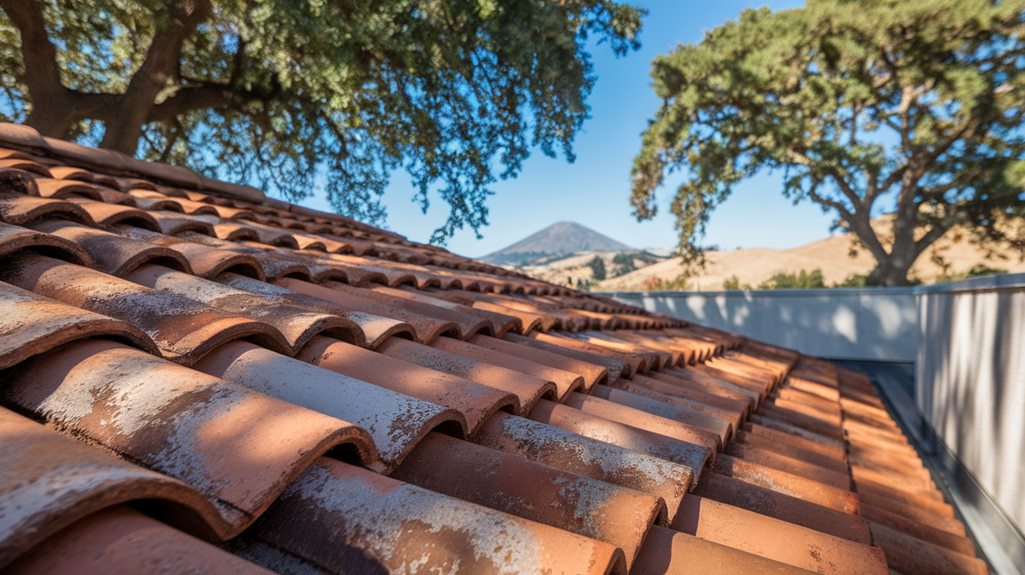
Building on the advanced weatherproofing features, modern roofing materials in Walnut Creek now consistently achieve a 40-plus year lifespan. You'll find that today's roofing systems combine multiple layers of protection with innovative materials that stand up to the area's varying temperatures and occasional heavy rains.
To maximize your roof’s longevity in Walnut Creek’s climate, you’ll want to focus on materials and features that have proven their durability: To maximize your roof’s longevity in Walnut Creek’s climate, you’ll want to focus on materials and features that have proven their durability: for instance, choosing tiles or metal options that withstand the region’s weather patterns. Regular maintenance, such as clearing debris and inspecting for wear, can significantly extend the life of your roof. Understanding Walnut Creek’s climate will also guide you in selecting appropriate insulation and ventilation systems, ensuring your roof can effectively handle both the heat of summer and the occasional rainstorms.
- Composite shingles with algae-resistant granules that maintain their protective properties for four decades or more
- High-grade underlayment systems that prevent moisture infiltration even after extensive UV exposure
- Impact-resistant materials that won't crack or split during temperature fluctuations between summer and winter
- Built-in ventilation channels that regulate temperature and prevent moisture buildup in your attic space
- Multi-layer sealant systems that maintain their flexibility and adhesion throughout decades of weather exposure
When you're selecting these long-lasting materials, you'll need to verify their warranty coverage matches their expected lifespan. Most premium manufacturers now back their products with 40-50 year warranties, giving you confidence in their durability claims.
Low-Maintenance Versus Installation Costs
Value presents a key consideration when weighing low-maintenance roofing materials against their higher installation costs in Walnut Creek. You'll find that premium materials like slate, metal, and high-end composite shingles carry steeper upfront costs but require minimal maintenance over their lifespans. For instance, a metal roof might cost $15-$25 per square foot to install, but you won't need to repair or replace it for 50+ years.
In contrast, traditional asphalt shingles offer lower installation costs at $5-$8 per square foot but demand regular maintenance and typically need replacement within 20 years. When you calculate long-term expenses, you'll discover that low-maintenance materials often prove more economical. Metal roofing's resistance to Walnut Creek's occasional extreme weather means you'll avoid costly storm damage repairs. Similarly, slate's imperviousness to rot and insects eliminates pest-related maintenance costs. You'll also save on routine maintenance like cleaning and moss removal with these premium materials. While the initial investment might seem challenging, factoring in reduced maintenance costs, longer lifespans, and improved property values can justify choosing higher-end roofing materials for your Walnut Creek home.
14-18 per Square Foot
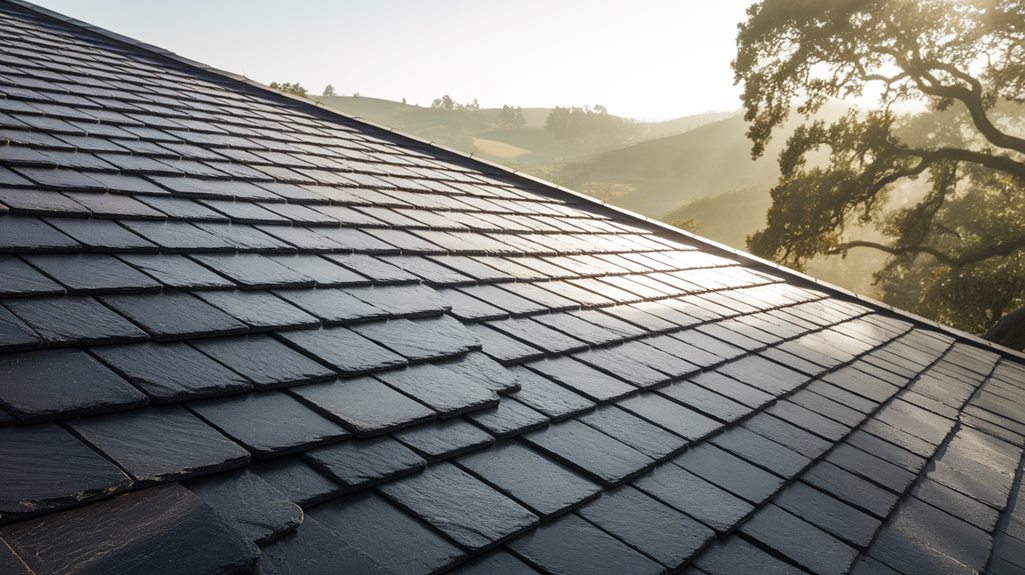
When considering premium roofing options in Walnut Creek, the $18 per square foot price point represents a mid-range investment that typically includes materials like architectural shingles and basic metal roofing systems. At this price range, you'll get quality materials that can withstand Walnut Creek's hot summers and occasional winter storms while providing reliable protection for 20-30 years.
You'll find several roofing options available at the $18 per square foot price point that offer excellent value for your investment:
- High-grade architectural shingles with enhanced UV protection and wind resistance up to 130 mph
- Standing seam metal panels with corrosion-resistant coatings
- Synthetic slate alternatives that mimic natural stone's appearance
- Impact-resistant composite materials with Class 4 ratings
- Premium asphalt shingles with advanced granule technology
The $18 price point also typically includes professional installation by certified contractors, underlayment materials, and basic ventilation components. While it's higher than basic roofing options, you'll benefit from improved durability, better energy efficiency, and enhanced curb appeal. When properly installed and maintained, these materials can help you avoid costly repairs and extend your roof's lifespan in Walnut Creek's climate conditions.
Metal Standing Seam Roofing
Among the premium roofing options mentioned at the $18 per square foot range, metal standing seam roofing stands out as a top performer for Walnut Creek homes. You'll find that this roofing system features continuous panels running from your roof's ridge to the eaves, with raised interlocking seams that create distinctive vertical lines while keeping water out.
In Walnut Creek's Mediterranean climate, metal standing seam roofs excel by reflecting solar heat, reducing your cooling costs during hot summers. You can expect these roofs to last 40-70 years with minimal maintenance, making them a cost-effective long-term investment. They're also fire-resistant, which is essential in California's wildfire-prone regions.
You'll appreciate that metal standing seam roofs can withstand wind speeds up to 140 mph and won't crack, shrink, or erode. They're available in various colors and materials, including aluminum, steel, and zinc. While the initial cost is higher than traditional asphalt shingles, you'll save money through reduced energy bills, lower insurance premiums, and minimal repair needs. Plus, these roofs are 100% recyclable when they eventually need replacement, making them an environmentally responsible choice.
Withstands 120-Mph Coastal Winds
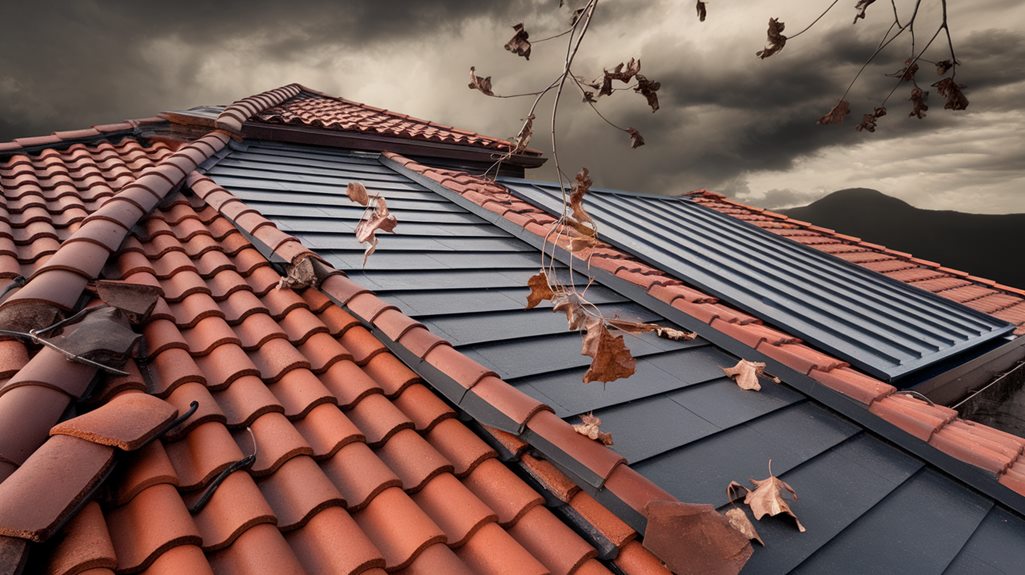
Coastal winds whipping off the San Francisco Bay pose a significant challenge for Walnut Creek homeowners. You'll find that metal standing seam roofs are engineered to withstand winds up to 120 mph, making them an ideal choice for your Bay Area home. These roofs feature interlocking panels that create a virtually impenetrable barrier against intense gusts and wind-driven rain.
The wind resistance of these roofs comes from several key design features:
- Vertical seams are mechanically crimped together, eliminating loose edges that could catch wind
- Concealed fasteners prevent water infiltration and reduce the risk of panel uplift
- Heavy-gauge metal panels provide superior structural integrity
- Clips allow for thermal expansion while maintaining a secure hold
- Strategic panel length limitations reduce stress points during high winds
When properly installed, your metal standing seam roof won't just withstand these extreme conditions – it'll maintain its integrity for decades. The system's design allows it to flex slightly with wind pressure rather than resisting it, much like a reed bending in the breeze. This flexibility, combined with its robust construction, guarantees your roof stays secure even during the Bay Area's strongest wind events.
Fire-Resistant Metal Panels
Beyond their impressive wind resistance, metal roofing panels offer exceptional fire protection for your Walnut Creek home. These panels earn a Class A fire rating, the highest possible classification, making them particularly valuable in California's wildfire-prone regions. You'll find that metal roofs won't ignite when exposed to flying embers, which often travel miles ahead of advancing wildfires.
Metal panels resist fire through multiple mechanisms. They'll reflect radiant heat, preventing your attic from reaching dangerous temperatures. The non-combustible nature of steel, aluminum, and zinc panels means they won't fuel a fire's spread, unlike traditional wood shakes or asphalt shingles. You can enhance this protection by installing fire-resistant underlayment beneath the panels.
When you're selecting metal roofing, you'll want to look for specific fire-resistant features. Look for panels with interlocking edges that prevent ember infiltration and choose a system that includes ember-proof ridge vents. Many insurance companies will offer premium discounts for homes with metal roofs, recognizing their superior fire protection. In Walnut Creek's climate, where summer wildfires pose an increasing threat, metal roofing provides essential defense for your home's safety.
Cost Averages .50/Sqft Locally
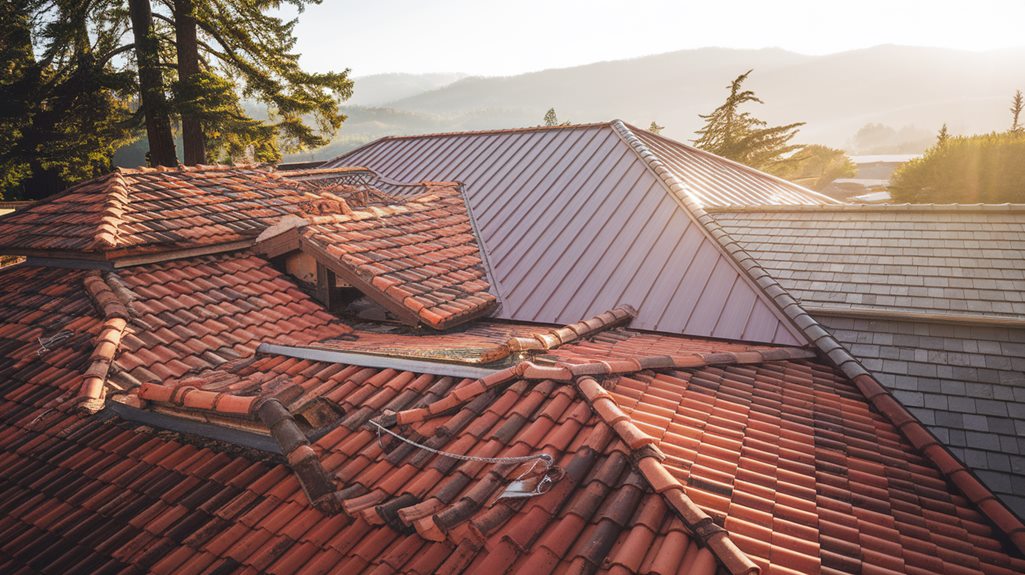
When planning your metal roof installation in Walnut Creek, you'll find local costs averaging $16.50 per square foot, including materials and labor. This price point reflects the region's competitive market and accounts for high-quality metal panels that withstand the area's specific climate conditions.
While the upfront cost might seem higher than traditional asphalt shingles, you'll benefit from significant long-term savings through:
- Reduced energy bills due to superior heat reflection
- Minimal maintenance requirements over 50+ years
- Insurance premium discounts for fire-resistant materials
- Enhanced property value and curb appeal
- Lower lifetime cost compared to replacing asphalt every 20 years
You can expect variations in your final cost based on your roof's complexity, the specific metal type you choose, and current market conditions. Steel panels typically start at $14 per square foot, while premium materials like copper can reach $22 per square foot. Don't forget to factor in removal costs of existing roofing materials, which typically add $2-3 per square foot to your project. Most local contractors offer financing options to help manage the initial investment, making metal roofing a practical choice for your Walnut Creek home.
Seasonal Moss Growth Issues
Three key factors in Walnut Creek's climate create ideal conditions for moss growth on roofs: high winter rainfall, moderate temperatures, and shaded areas from surrounding trees. You'll notice moss typically developing on north-facing roof sections and under tree canopies, where moisture lingers longest after winter storms.
To prevent moss damage, you'll need to address these issues proactively. Start by trimming overhanging branches to increase sunlight exposure and reduce debris accumulation. Installing zinc or copper strips near the roof's ridge will create a natural antimicrobial barrier as rainwater flows down the surface. You should also ensure appropriate attic ventilation to minimize moisture buildup underneath your roofing materials.
If you've already spotted moss growth, don't use a pressure washer – it'll harm your shingles. Instead, apply a moss-killing solution specifically designed for roofs, and gently remove dead growth with a soft-bristled brush. You can prevent future moss issues by choosing moss-resistant materials like copper-infused architectural shingles or cedar shakes treated with preservatives. Regular maintenance, including gutter cleaning and debris removal, will notably reduce your roof's susceptibility to moss growth throughout Walnut Creek's wet seasons.
Flashing Seal Failures
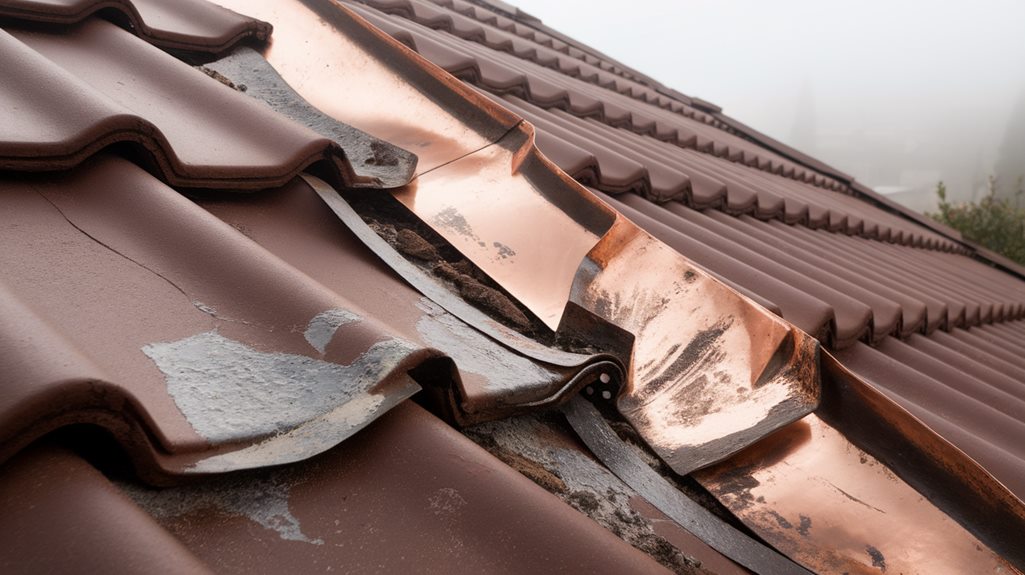
Flashing seal failures represent one of the most common roofing problems you'll encounter in Walnut Creek's variable climate. When the metal flashing around your chimneys, vents, and roof valleys deteriorates, it creates vulnerable points where water can seep into your home's structure. The region's wet winters and hot summers cause repeated expansion and contraction, which stresses these critical seals.
To protect your roof from flashing failures, you'll need to watch for these warning signs:
- Rust spots or corrosion on metal flashing surfaces
- Gaps between the flashing and roof materials
- Cracked or dried-out sealant around penetration points
- Water stains on interior walls near chimneys or vents
- Loose or missing flashing pieces after strong winds
Don't wait until you spot water damage inside your home. Schedule regular inspections to catch flashing issues early, especially if your roof is over 10 years old. When you're replacing flashing, choose materials designed for Walnut Creek's climate fluctuations. High-quality aluminum or copper flashing with proper overlapping and modern sealants will provide the best protection against leaks and extend your roof's lifespan.
Bay Area Fog Exposure
Bay Area homes must deal with persistent coastal fog rolling in off of the Pacific, which creates unique challenges for roofing materials in Walnut Creek. When fog settles on your roof, it creates a consistently damp environment that can lead to moss growth, algae formation, and premature deterioration of certain roofing materials.
You'll need to ponder materials that resist moisture retention and biological growth. Clay and concrete tiles work well in foggy conditions, as they're naturally resistant to moisture damage and allow proper ventilation. Metal roofing is another excellent choice, as water quickly runs off its smooth surface, preventing the accumulation of dampness that can compromise other materials.
If you've chosen asphalt shingles, you should opt for varieties treated with algae-resistant copper or zinc granules. These treatments help prevent the black streaks and discoloration that often appear on roofs exposed to frequent fog. Additionally, you'll want to make sure your roof has adequate ventilation and drainage systems to combat the excess moisture. Regular maintenance, including cleaning gutters and removing any moss buildup, becomes especially important when you're dealing with Bay Area fog exposure.
Reinforced Zinc Ridge Repairs
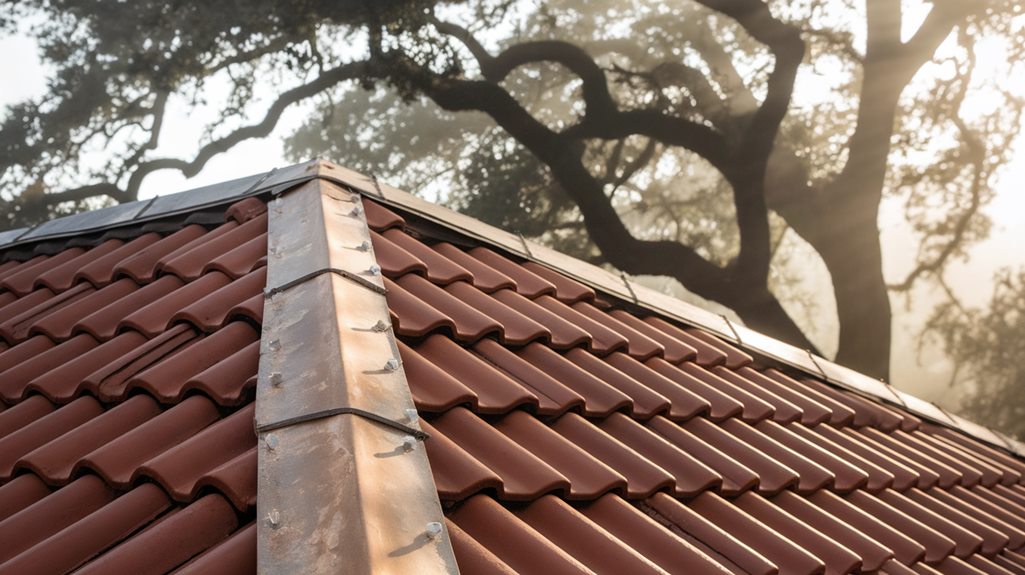
Reinforced zinc ridge repairs represent a crucial maintenance task for Walnut Creek homes, especially in areas with high wind exposure. You'll need to address these repairs promptly to prevent water infiltration and structural damage to your roof's highest point. When dealing with zinc ridge repairs, understanding that proper reinforcement techniques can prolong your roof's lifespan by 10-15 years is crucial.
The repair process demands specific attention to local weather patterns and installation methods. You should consider these key factors for successful zinc ridge reinforcement:
- Utilize marine-grade fasteners to prevent corrosion from Bay Area fog
- Apply elastomeric sealant tailored for temperature fluctuations between 40-90°F
- Place additional support brackets every 24 inches along the ridge line
- Select zinc alloys with a minimum of 99.5% purity for maximum durability
- Integrate ventilation gaps to prevent moisture accumulation
Avoid trying to repair zinc ridges during wet conditions or when fog is present, as moisture can jeopardize the bonding process. It's advisable to schedule these repairs during Walnut Creek's dry season, typically from late spring through early fall, when temperatures are most suitable for proper material adhesion and curing.
Asphalt Shingle Granule Loss
Deterioration of asphalt shingle granules poses a significant threat to Walnut Creek homes, particularly during the region's intense summer heat. You'll notice granule loss when you spot accumulation in your gutters or at the base of downspouts, indicating your roof's protective layer is wearing thin.
When your shingles lose their granules, they become vulnerable to UV damage and accelerated aging. These mineral granules shield the asphalt coating from sunlight and help regulate your home's temperature. In Walnut Creek's climate, where temperatures can fluctuate substantially between seasons, maintaining this protective layer is essential.
You can assess granule loss by examining your shingles for bald spots or areas that appear darker than surrounding sections. If you're seeing excessive granule shedding, especially in shingles less than 10 years old, you'll need professional inspection. Don't wait until you spot leaks – addressing granule loss early can prevent costly structural damage.
To protect against premature granule loss, ensure proper attic ventilation and consider upgrading to architectural shingles with enhanced granule adhesion. You'll also want to schedule regular maintenance checks, particularly after severe weather events or extreme temperature fluctuations.
Persistent UV Ray Damage
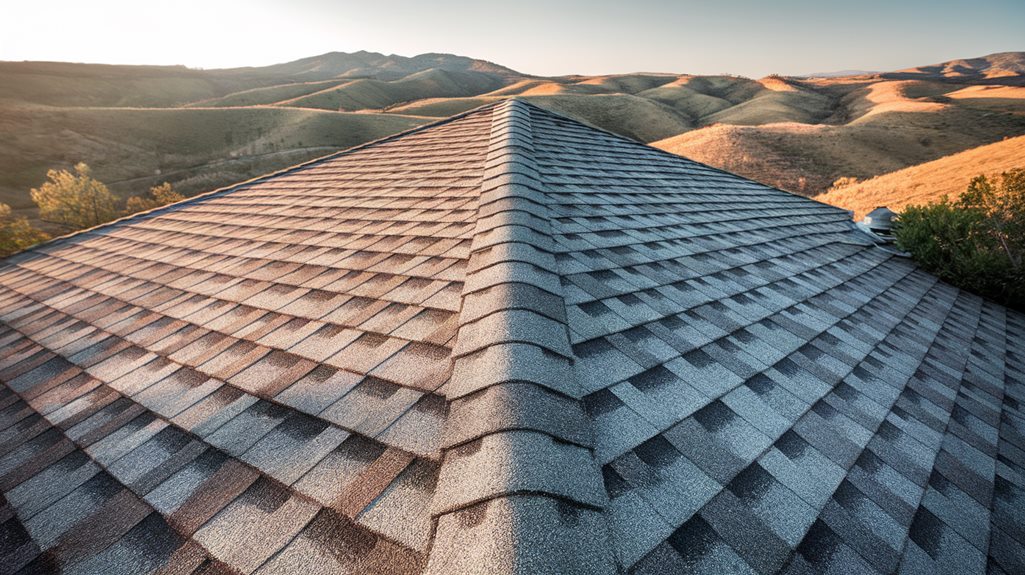
Under Walnut Creek's intense sunshine, UV rays persistently bombard roofing materials throughout the year, breaking down their chemical composition. You'll notice this degradation most prominently in asphalt shingles, where UV exposure causes oils to evaporate and materials to become brittle over time.
To protect your roof from UV damage, you'll need to understand how different materials respond to prolonged sun exposure. While all roofing materials eventually show signs of UV wear, some hold up better than others in Walnut Creek's climate.
- Clay tiles naturally resist UV damage and maintain their color, often lasting 50+ years with minimal degradation
- Metal roofing with proper UV-resistant coatings can reflect up to 85% of solar radiation
- Concrete tiles become more durable over time as they cure, developing increased UV resistance
- Synthetic slate contains UV inhibitors that prevent breakdown and maintain structural integrity
- Modified bitumen roofing with light-colored granules reflects UV rays effectively
You'll want to inspect your roof regularly for signs of UV damage, such as color fading, material warping, or surface cracking. Early detection of these issues helps prevent more serious structural problems down the line.
Waterproof Membrane Underlayment Installation
Properly set up waterproof membrane underlayment serves as your roof's critical defense against Walnut Creek's seasonal rains and moisture intrusion. You'll want to make sure your contractor starts by cleaning and drying the roof deck completely before applying the membrane. For Walnut Creek's climate, a high-quality synthetic underlayment with a minimum thickness of 40 mils is recommended.
Begin installation at your roof's lowest point, working upward with a minimum 6-inch overlap between horizontal seams and 12-inch overlap at vertical joints. You'll need special attention at valleys, where water flow concentrates during winter storms. In these areas, your contractor should install an extra layer of membrane protection, extending at least 24 inches on each side of the valley centerline.
Don't overlook proper sealing around roof penetrations like vents, chimneys, and skylights. Each penetration requires careful detailing with appropriate flashing and membrane integration. For best results, you'll want the membrane to extend up vertical surfaces at least 4 inches, creating a watertight seal that prevents water from seeping behind the underlayment during Walnut Creek's rainy season.
Composite Shingle Performance Standards
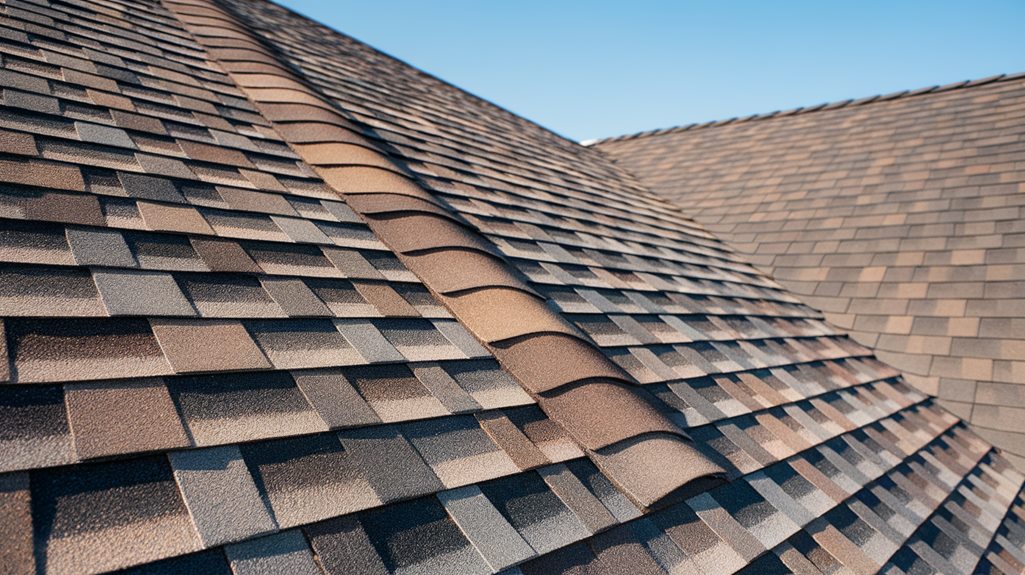
For ideal protection in Walnut Creek's diverse weather conditions, composite shingles must meet rigorous performance standards. You'll want to confirm your chosen shingles meet Class A fire ratings and wind resistance ratings of at least 110 mph to handle the area's occasional strong gusts. The material should also demonstrate proven durability against UV exposure, as Walnut Creek experiences significant sun throughout the year.
When selecting composite shingles, validate they meet these essential performance criteria:
- Impact resistance rating of Class 4, offering maximum protection against hail and falling debris
- ASTM D3462 certification, validating the shingle's structural integrity and manufacturing quality
- Energy Star certification for improved thermal performance and reduced cooling costs
- Algae resistance rating (AR) of at least 10 years to prevent unsightly staining
- Minimum 30-year manufacturer's warranty covering both materials and labor
You'll find that quality composite shingles meeting these standards typically cost more upfront but deliver superior long-term value. They'll resist cracking, curling, and color fading while maintaining their protective properties throughout Walnut Creek's hot summers and wet winters. Don't forget to verify your contractor's installation meets manufacturer specifications to maintain warranty coverage.
Expert Roofer Selection Process
Selecting a qualified roofer in Walnut Creek requires careful research and due diligence. You'll want to verify that your chosen contractor holds a valid California C-39 roofing license and maintains current liability insurance and workers' compensation coverage. Check their license status through the Contractors State License Board (CSLB) website and request proof of insurance directly.
Start by gathering recommendations from neighbors who've had recent roof work, and review online ratings on platforms like BBB and HomeAdvisor. You should obtain at least three detailed estimates from different contractors, ensuring each one includes material specifications, timeline, warranty terms, and cleanup procedures. Don't hesitate to ask for references from previous clients in Walnut Creek, particularly those with similar roofing projects completed in the last year.
When interviewing potential contractors, ask about their experience with your chosen roofing material and their familiarity with Walnut Creek's building codes and permit requirements. They should demonstrate knowledge of local climate challenges and appropriate ventilation solutions. Make sure they're willing to provide a written contract that specifies payment terms, project scope, and dispute resolution procedures. Finally, confirm they'll pull necessary permits and schedule required inspections.
Check BBB Rating First
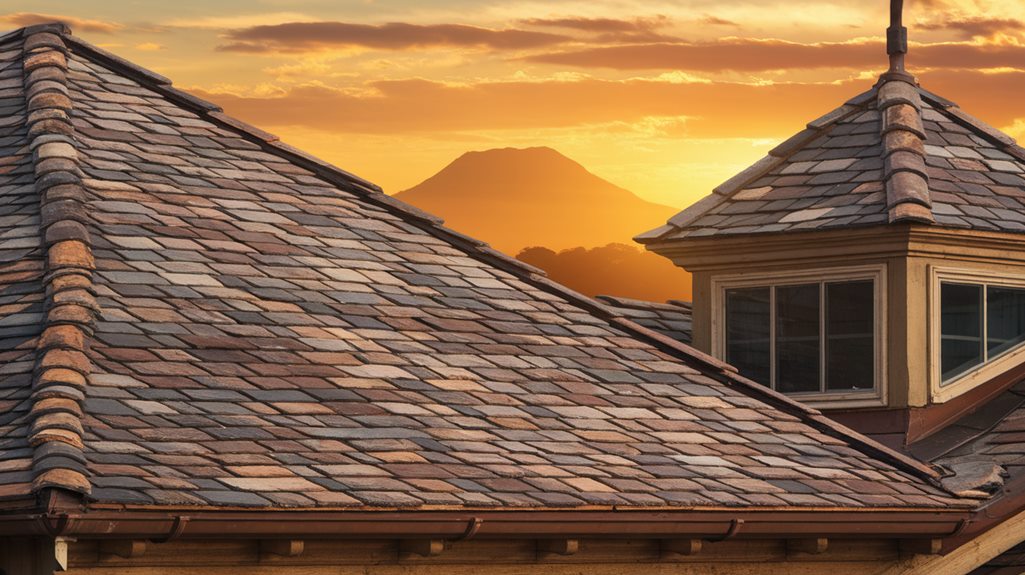
Before pursuing recommendations or interviewing contractors, you should investigate potential roofers through the Better Business Bureau (BBB). The BBB rating gives you essential insights into a company's reliability, customer service history, and overall reputation in Walnut Creek's roofing industry. A high BBB rating indicates that the contractor consistently meets professional standards and resolves customer issues effectively.
When checking a roofer's BBB profile, you'll want to focus on these key elements:
- Review the letter grade rating (A+ to F) which reflects the BBB's confidence in the business
- Examine the number and nature of complaints filed against the company
- Check how long the contractor has maintained BBB accreditation
- Read customer reviews and the company's responses to them
- Verify if there are any government actions or licensing issues
Don't limit yourself to just the overall rating. Take time to analyze the detailed report, which includes the company's time in business, licensing information, and complaint resolution process. If you notice multiple unresolved complaints or a pattern of similar issues, consider it a red flag and continue your search for a more dependable roofing contractor.
C-39 License Verification Required
After confirming a roofer's BBB rating, verifying their C-39 license through California's Contractors State License Board (CSLB) is crucial. This specialized roofing contractor license demonstrates the professional has met California's strict requirements for roofing work. Legitimate roofers typically showcase their license number on their business cards, websites, and vehicles.
To authenticate a license, visit the CSLB website and input the contractor's license number or business name. It is important to ensure that the license is current, active, and specifically designated as C-39. Verify the existence of workers' compensation insurance coverage, particularly due to the significant safety hazards involved in roofing work. Additionally, check for any disciplinary actions or complaints lodged against the contractor.
Do not overlook this validation process, even if a roofer receives high recommendations. Operating without a valid C-39 license in Walnut Creek is unlawful and jeopardizes your project. In case of mishaps, you may not be eligible for assistance from CSLB's recovery fund, and damages caused by an unlicensed contractor may not be covered by your homeowner's insurance. Remember to document the license number and verification date for future reference.
Verify Bonding and Insurance
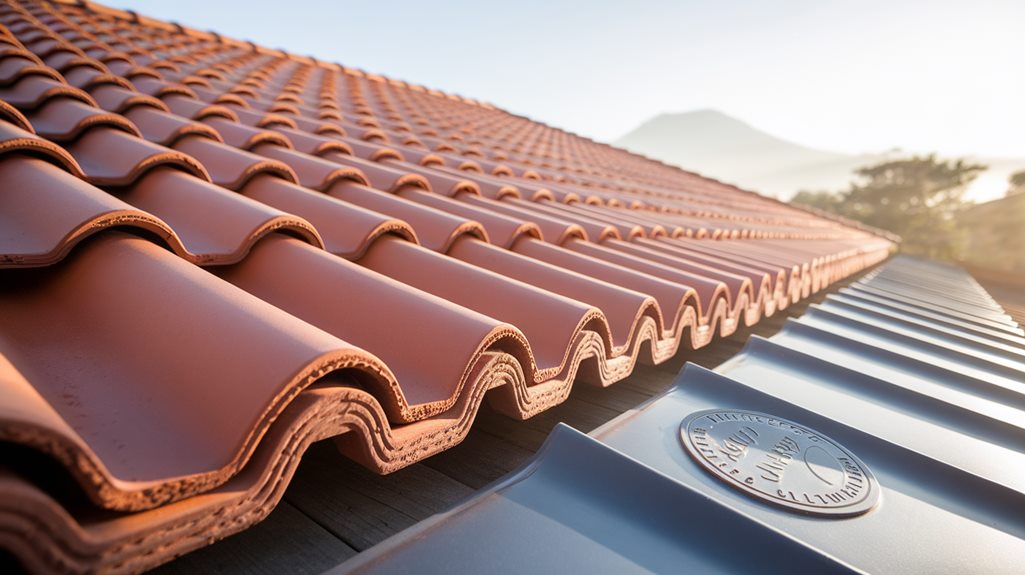
Beyond license verification, proper bonding and insurance represent two fundamental safeguards when hiring a roofing contractor in Walnut Creek. You'll need to confirm that your contractor carries both contractor's bond and adequate insurance coverage before signing any agreements.
Request proof of these essential protections:
- General liability insurance (minimum $1 million coverage) to protect your property from damage during the roofing project
- Workers' compensation insurance to cover any worker injuries that might occur on your property
- Contractor's bond (typically $15,000 in California) to protect you from financial losses due to incomplete or subpar work
- Proper vehicle insurance for all company trucks and equipment that'll be on your property
- Written proof of current policy status with clear expiration dates
Don't hesitate to contact the insurance carriers directly to verify coverage. It's your right to request current certificates of insurance, and legitimate contractors will readily provide this documentation. Keep copies of all insurance and bonding documents in your project file, and [CONFIRM] the coverage dates extend beyond your project's expected completion date.
Inspect Completed Nearby Installations
Looking out for successful roofing projects in your neighborhood provides tangible proof of a contractor's workmanship. Ask your potential roofer for addresses of completed installations in Walnut Creek, particularly those that have endured multiple seasons. You'll want to see roofs that have faced both summer heat and winter rains.
When inspecting these installations, pay attention to the uniformity of shingle placement, clean line work around chimneys and vents, and proper flashing installation. Look for signs of proper drainage and ventilation systems. Note how the materials have weathered – they should show consistent aging without patches of premature wear.
Don't hesitate to knock on doors and talk to homeowners about their experience with the contractor. Ask specific questions about the installation process, timeline adherence, and any issues that arose after completion. If possible, view roofs of similar age and material to what you're considering. This comparison will help you understand how different materials perform in Walnut Creek's Mediterranean climate. Check for proper valley construction and ridge cap installation, as these areas often reveal the quality of workmanship.
Compare Three Roofing Bids
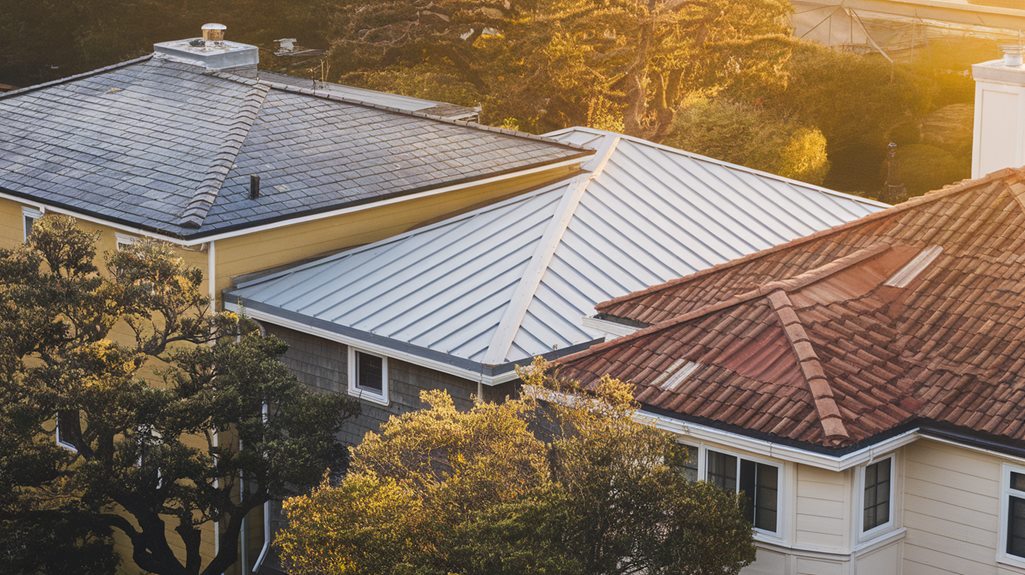
Armed with insights from local installations, you're ready to evaluate multiple roofing proposals. When comparing three different bids, you'll need to make sure you're making an apples-to-apples comparison of materials, labor, and warranties. Request detailed written estimates that break down all costs and specifications.
Look for these key elements in each bid:
- Material quality and manufacturer specifications, including brand names and product lines
- Labor costs and estimated project timeline, including crew size
- Warranty terms for both materials and workmanship
- Disposal and cleanup procedures
- Detailed payment schedule and terms
When reviewing the bids, don't automatically choose the lowest price. You'll want to take into account the contractor's reputation, experience with your chosen materials, and their track record in Walnut Creek's climate. Pay special attention to how each contractor plans to address ventilation and insulation, as these aspects significantly impact your roof's performance in local weather conditions.
If there are significant price differences between bids, ask the contractors to explain what accounts for the variation. Sometimes higher bids include premium materials or additional services that could prove valuable over time.
Door-To-Door Roofing Solicitors
You shouldn't sign any contracts or make payments without first verifying the contractor's credentials. Check if they have a valid California contractor's license, liability insurance, and workers' compensation coverage. You can verify their license number through the Contractors State License Board's website.
Be wary of contractors who demand large upfront payments or pressure you to make an immediate decision. In California, the down payment for home improvement contracts can't exceed $1,000 or 10% of the contract price, whichever is less.
If you're approached by a roofing solicitor, take these steps: request their business card, research their company online, check for complaints with the Better Business Bureau, and contact their references. Don't let anyone inspect your roof without proper verification. Instead, work with established local contractors who've built a solid reputation in Walnut Creek and understand the area's specific climate challenges.
Ridge View Estates Project
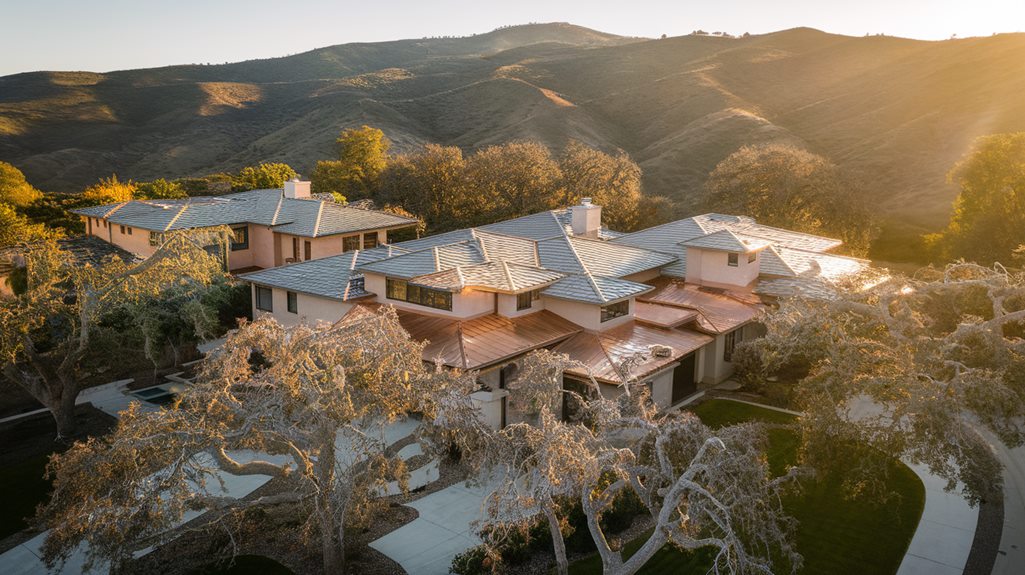
The Ridge View Estates project represents a significant residential development in Walnut Creek where roofing design has played a pivotal role in enhancing the community's aesthetic appeal. When you're examining this development, you'll notice how the architects carefully selected materials that complement the area's Mediterranean climate while maintaining durability against seasonal variations.
The project's roofing specifications have set new standards for residential developments in Contra Costa County. You'll find that each home features high-performance composite shingles rated for wind resistance up to 130 mph, with specialized underlayment systems designed for moisture control.
- Each roof incorporates cool-roof technology, reflecting up to 65% of solar heat
- Ridge vents are strategically placed to maximize airflow and reduce attic temperatures
- All homes feature copper flashing at roof-to-wall intersections for superior leak protection
- Secondary water barriers are installed beneath all valley areas
- Solar panel pre-installation supports are integrated into the roof structure
If you're considering a similar roofing approach for your property, you'll want to note that the Ridge View specifications have proven particularly effective in managing both summer heat and winter rainfall patterns typical to Walnut Creek.
Steep-Slope Copper Dome Installation
Building upon the success of Ridge View's roofing innovations, steep-slope copper dome installations have emerged as striking architectural features throughout Walnut Creek's upscale neighborhoods. You'll need specialized expertise to install these distinctive elements, as copper domes require precise measurements and careful handling to prevent damage during the installation process.
When you're planning a copper dome installation, you'll want to take into account the 60-degree minimum slope requirement that guarantees proper water runoff and prevents moisture accumulation. You must use double-locked standing seams and high-quality underlayment materials to protect against Walnut Creek's occasional winter storms and summer heat.
The copper material you'll select should be at least 20-ounce weight for durability, and you'll need to install proper ventilation systems to prevent condensation buildup underneath the dome. Don't forget to factor in thermal expansion – copper can move up to an inch over a 100-foot span as temperatures fluctuate. You'll also want to integrate a lightning protection system, as copper domes can attract strikes during storms. While the initial green appearance will develop into a distinguished patina over time, you can apply protective coatings to maintain the original copper finish if desired.
Parkview Heights Slate Project
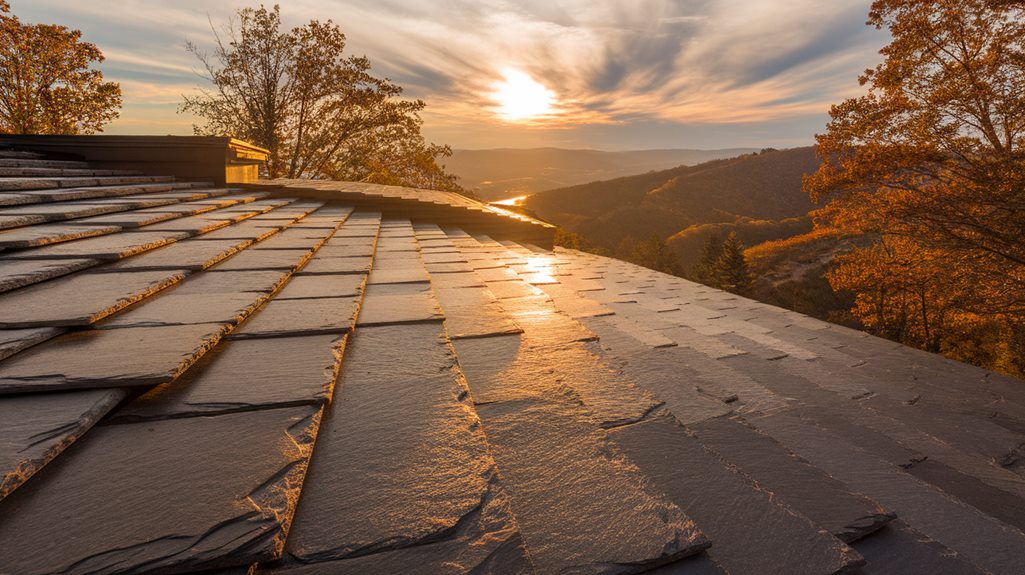
Several impressive slate installations at Parkview Heights showcase Walnut Creek's growing appreciation for premium roofing materials. You'll find that these high-end homes feature Vermont slate, known for its superior quality and natural variations in color. The project's success demonstrates how slate roofing can withstand Walnut Creek's intense summer heat while maintaining its aesthetic appeal.
When you examine the Parkview Heights installation, you'll notice these key features:
- Individual slate tiles are hand-split to 3/8-inch thickness, ensuring ideal weight distribution
- Copper flashings and valleys complement the slate's natural beauty while preventing water intrusion
- Double-layer underlayment provides additional protection against rare but heavy winter rains
- Each slate piece is individually secured with copper nails, allowing for thermal expansion
- Custom-cut ridge caps create clean, precise lines along the roofline
You'll need to take into account that slate installation requires specialized expertise, which the Parkview Heights project clearly exhibits. The contractors used traditional hand-tools alongside modern cutting equipment to achieve precise fits. This attention to detail has resulted in a roof that's projected to last over 100 years with proper maintenance.
Expert Ratings Summary
Leading roofing experts have evaluated common materials for Walnut Creek homes, rating them on durability, energy efficiency, and cost-effectiveness. You'll find that concrete tiles rank highest overall, scoring 9/10 for their 50+ year lifespan and excellent resistance to Walnut Creek's occasional temperature swings. Clay tiles follow closely at 8.5/10, particularly excelling in summer heat reflection.
Metal roofing systems earned an 8/10 rating, with experts praising their 40-year durability and energy-saving properties. You can expect 30% lower cooling costs compared to traditional asphalt shingles. Composite shingles received a 7.5/10, offering good value for their 25-30 year lifespan and moderate weather resistance.
Traditional asphalt shingles scored 6/10, with experts noting their affordability but shorter 15-20 year lifespan in Walnut Creek's climate. Slate roofing, while scoring 9/10 for durability, rated 6/10 overall due to its high installation costs and structural requirements. When you're choosing materials, remember that these ratings factor in Walnut Creek's specific climate patterns, including hot summers, mild winters, and occasional heavy rains.
Valley-Wide Roofing Recommendations Overview
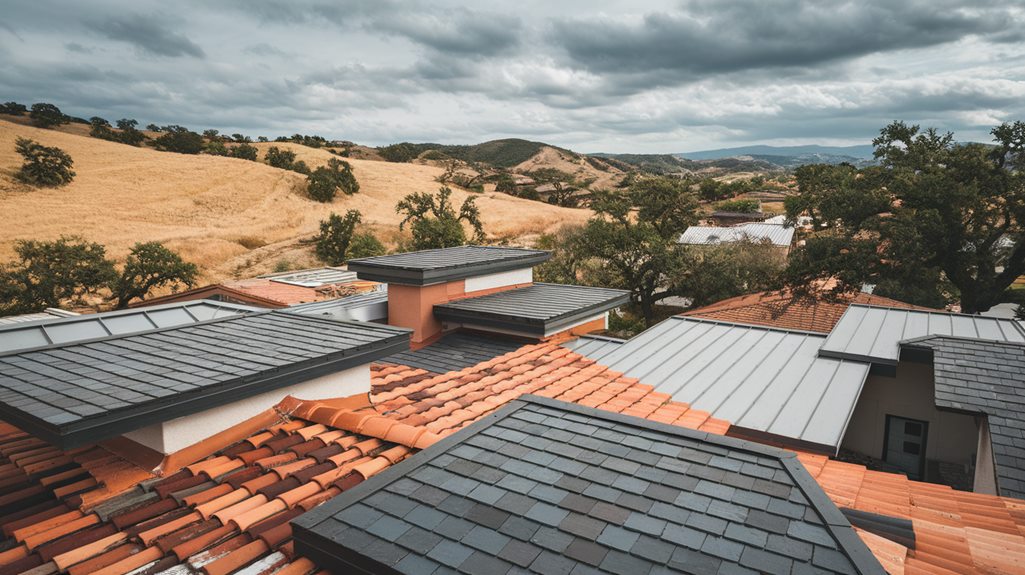
Residential experts across the Walnut Creek Valley have identified distinct roofing needs based on each neighborhood's unique exposure and elevation. When you're selecting materials for your home, you'll need to take into account your specific location within the valley, as different areas face varying levels of sun exposure, wind patterns, and moisture retention.
- North Valley homes often benefit from lighter-colored materials that reflect heat, with clay tiles and cool-rated composite shingles performing exceptionally well
- Downtown and central neighborhoods should prioritize materials with excellent drainage properties due to their location in natural water collection areas
- South Valley residents typically need extra UV protection, making high-grade architectural shingles with enhanced granule coating ideal
- Elevated properties along the ridgelines require wind-resistant materials like interlocking tiles or impact-rated shingles
- Properties in tree-dense areas need Class A fire-rated materials and enhanced impact resistance
You'll find that matching your roofing material to your home's specific location within the valley isn't just about aesthetics – it's about maximizing your roof's lifespan and protecting your investment. Take into consideration consulting local contractors who understand these micro-climate variations for the best results.
Request Free Quote Today
Now that you understand which roofing materials work best for your area, the next step is getting an accurate quote for your project. You'll want to contact at least three reputable local roofing contractors who specialize in your chosen material and have experience with Walnut Creek's climate conditions.
When requesting your free quote, make sure you have specific details ready: your roof's approximate square footage, current roofing material, any known damage or leaks, and your preferred new material. You'll also need to specify if you're planning a complete tear-off or an overlay installation.
The contractor should schedule an in-person inspection to provide an accurate estimate. During this visit, they'll assess your roof's condition, check the structural integrity, and identify any potential challenges. They'll measure the roof's dimensions and examine factors like pitch, valleys, and ventilation requirements.
Your written quote should include material costs, labor expenses, removal of old materials, disposal fees, and warranty information. Don't hesitate to ask questions about timeline, payment terms, and required permits. Most local contractors offer free, no-obligation quotes, so you can compare options before making your decision.
Lifetime Cost Savings Analysis
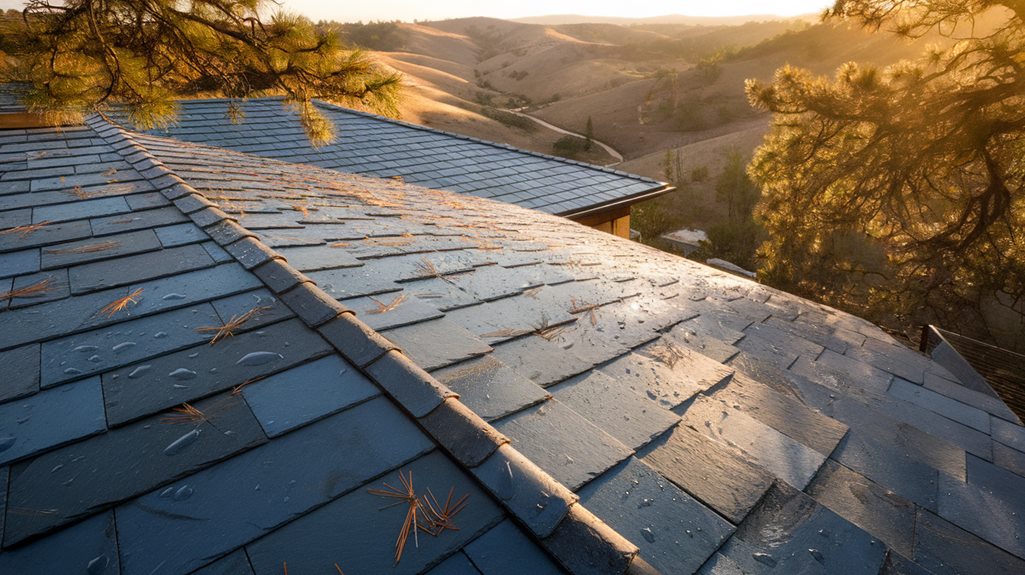
When assessing roofing materials for your Walnut Creek residence, understanding the long-term financial impact is crucial. While initial costs might appear challenging, you'll need to contemplate factors like durability, maintenance requirements, and energy efficiency to calculate true lifetime costs.
- Clay tiles offer 50+ years of service with minimal upkeep, offsetting their higher upfront expense through reduced replacement needs
- Metal roofing's reflective properties can reduce cooling expenses by up to 25%, leading to significant energy savings over its 40-60 year lifespan
- Asphalt shingles, though more affordable initially, may require replacement every 20 years, resulting in higher cumulative costs
- Cool roofing materials can qualify for local energy rebates and tax incentives, reducing your overall investment
- Proper installation and regular maintenance can prolong any roof's lifespan by 20-30%, maximizing your return on investment
Summer Roof Ventilation Options
During Walnut Creek's hot summer months, proper roof ventilation becomes essential for protecting your home and maintaining energy efficiency. You'll need a combination of intake and exhaust vents to create effective airflow that removes trapped heat from your attic space.
Ridge vents offer one of the most efficient solutions, running along your roof's peak to release hot air while maintaining a clean roofline. You can pair these with soffit vents installed under your eaves for ideal air circulation. If your home can't accommodate ridge vents, consider installing static roof vents, which don't require electricity and work through natural convection.
For enhanced ventilation, you might want to add solar-powered attic fans, which operate at zero cost and work hardest during peak sun hours when you need them most. These fans can lower your attic temperature by up to 40 degrees, notably reducing your cooling costs. If you've got a larger roof area, consider installing multiple wind turbines, which spin with natural air movement to pull hot air out of your attic space. You'll also want to make sure your existing vents remain unobstructed by insulation or debris for maximum effectiveness.
Walnut Creek Building Department Guide
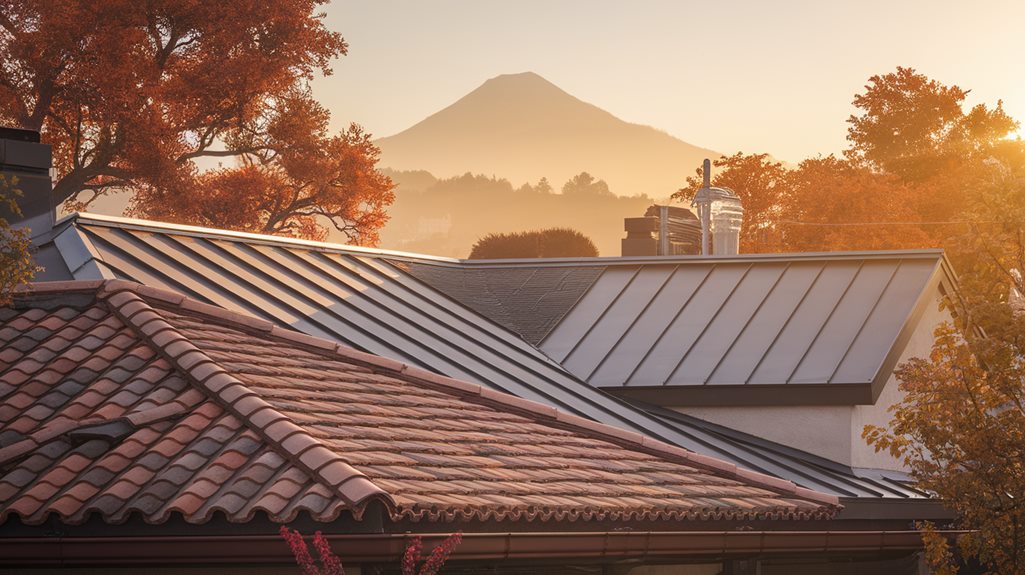
Before commencing any roofing project in Walnut Creek, you'll need to understand the city's building permit requirements. The Building Division at City Hall reviews all roofing applications to verify compliance with local building codes and safety standards. You'll find the permit process is straightforward when you're prepared with the right documentation.
The Walnut Creek Building Department requires these essential items for roofing permits:
- Complete permit application form with property owner's signature and contractor's license information
- Detailed project plans showing roof layout, materials, and structural calculations if needed
- Documentation of Title 24 energy compliance for new construction or significant modifications
- Proof of worker's compensation insurance and contractor's bond
- HOA approval letter if your property is part of a homeowner's association
You can submit your application in person at City Hall or through the online portal. The department typically processes residential roofing permits within 5-10 business days. Don't forget to schedule required inspections during your project – you'll need both a progress check and final inspection. Contact the Building Division at (925) 943-5834 if you have specific questions about your roofing permit requirements.
Conclusion
Protect your property perfectly by picking proven roofing materials that match Walnut Creek's weather patterns. You'll save substantially when you select sturdy solutions designed for durability. Don't delay decisions about defending your dwelling – contact credible contractors today for a free assessment of your roofing requirements. With wise weatherproofing choices, you're investing in lasting protection that'll preserve your home's value for years to come.

